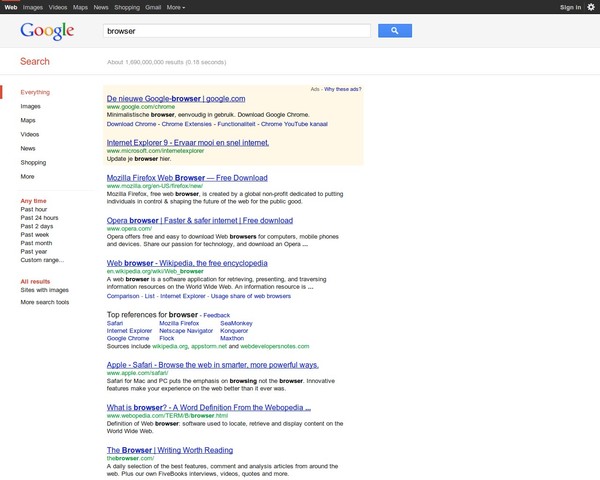Advertising on your own pages isn’t likely to cost a lot of money, so …
Is Google’s Chrome Reduced Pagerank a penalty?!
January 4th, 2012Apple’s refusal for adding Flash to iPad/iPhone has nothing to do with battery usage.
January 2nd, 2012Off course it was a brilliant marketing trick, everyone started writing about it and discussing the issue.
It even made a Dutch Newspaper define Adobe Flash as one of the losers in 2011. Which is one reason that triggered me to publish this post now, it has been a draft for nearly a year. Alas, the fate of many of my posts, no time to work out and state properly my (initial) thoughts.
The other reason is this remark Apple is the only dominant player in this game who has enough confidence in their own software, platforms and ecosystem, to truly have no interest in “owning” the web one way or another by Faruk Ateş.
Sorry, did I miss anything, aren’t patents supposed to let you own something and forbid others to use that. Aren’t patents a kind of owning a technology, a kind of a monopoly? Isn’t there a (many many many) lawsuit between Apple and Samsung. Wasn’t there an intial `bug` in iOS that made ipads not play HTML5 video if Apple`s own shared patented technology (H.264/MP4) wasn’t named first?.
Nice `bugs` to kickstart your own technology. Why did Apple oppose to a patent-free video format?
And sure flash can cause a huge CPU load, which strains the battery a lot. That’s true, but HTML5 / CSS3 animations do the same. There isn’t a real gain yet in playing a video in Flash or in HTML5, AFAIK.
The real reason for Apple refusal is the battle for video and audio codecs and formats on the internet. They were losing grip (what the hell is Quicktime) on how video and audio content was served to the web. Lately there were two ways, Flash, and since Olympic Games also Silverlight, Apple’s own plugin product Quicktime was dead meat, (despite pushing it with security updates for their browser and vice versa)
Flash is from Adobe and Silverlight is from Microsoft. Apple’s refusal to allow Flash did also mean there will be no Silverlight. So the Dutch Public Broadcast moved form Flash to Silverlight and now they moved to HTML5 for Ipad/Iphone only. Why other systems like Opera on Linux 64 are ruled out from HTML5 video seems weird, there has never been a good Linux 64 flash plugin, there is no support for Opera in Silverlight/Monolight.
The Dutch Public Broadcast moved to the Silverlight standard, not because it was technically superior or it was better supported, (Linux support has always been behind Windows support, Opera has never had support, Chrome had support only after a (few) years of existence). What’s a better way of consolidating the dominant position of the Windows market share on the PC OS market, then show the name Windows on every page of the Dutch Public Broadcast. They claimed they choose it because it offered better tracking of user statisitics. (?!). When the iPad was launched they immediately offered HTML5 video for Ipad only. If you don’t have an iPad you have to use Silverlight, even if it isn’t supported on your platform or browser of choice.
So what did Apple do, they were losing a battle, they flee/jumped forward to the new technology HTML5 but embracing only support for their own (shared) patented technoloy mp4/h.264. Everbody praised Apple…
Apple is the only dominant player in this game who has enough confidence in their own software, platforms and ecosystem, to truly have no interest in “owning” the web one way or another.
My ass!
Jobs was a visionary and smart business man. Like most bankers.
Nominate Git(hub) for the Nobel Peace Prize
December 7th, 2011Git is a decentralized or distributed revision control system. This means every programmers work together in a team, localized, but every team-member owns the complete code, it’s back-upped everywhere, not just on one place. Git has increased the speed and ease of development for open source projects enormously. Every one can contribute and pull requests are faster issued than writing an email.
Github is a website that hosts software development projects that are maintained with the Git version system. Github is free for open source projects and offers commercial plans for proprietary projects.
Working together on software with people from all over the world, thereby spreading creativity and collecting global cooperation is the best way to achieve fraternity between people, because there is no sense in raising standing armies and go to war, when we all want to achieve a common goal. A better working… , whatever.
The decentralized aspect of Git is thus very important. Leaders raise armies and make war. People want war because they’re influenced by leaders spreading the words of nationalism and patriotic or religious superiority.
People working with people all over the world know this is nonsense, we’re all different, but have an interest in the same goal. The minds of people are versatile, that makes working with Git(hub) such a fertile soil.
Hereby Webonomic nominates Git(hub) for the Nobel Peace Prize.
Who`s joining?
History pushState issues
December 6th, 2011Opera 11.60 broke navigation on our main website. It does not longer because I added a workaround.
It’s all related to setting the baseURI (wrongly) after ajax loading and history.pushState
To see the problem:
Open this page in Opera 11.60:
- http://www.webonomic.nl
- Click internet
- Inspect any element and readout the baseURI property, it’s set to
http://www.webonomic.nl/webdesign/internet
While Opera 11.52, Firefox and Chromium set it to
http://www.webonomic.nl/
according to the base href element of original the document.
I looked up the specs:
http://www.w3.org/TR/html5/webappapis.html#script-s-base-url
A base URL
A URL, set when the script is created, used to resolve relative URLs. If the base URL is set from another source, e.g. a document base URL, then the script’s base URL must follow the source, so that if the source’s changes, so does the script’s.
I’m not sure if a pushState is changing the source, I can imagine it does, so Opera’s 11.6 behaviour does make sense somewhere. On the other hand it doesn’t change the source of the script?
A couple of questions raise:
- Is Opera’s 11.60/12.00 new behaviour a bug?
- How do we set the base url of a json document?
- How do I set the base URL for a script?
To me Opera 11.5, Firefox, and Chromium’s behaviour does make sense by keeping the base URI of elements to the href attribute of the base element after a pushState event.
Can anyone shed some light?
(I decided to ask this question on the Opera Dev forum as well )
Why I use Opera as my main browser
{browser}November 8th, 2011
Yeah, I use it since the Phoenix Alpha’s but the main reason is…
Read the rest of this entry »
The beauty of WebGL
{webGL}July 1st, 2011
We have seen some demo’s with fishtanks and aquariums, but I found a much more elegant showcase here. It stresses the beauty of infinity and brings focus to the relationship between simplicity and complexity, often found in nature.
You can see the working example here:
http://wakaba.c3.cx/w/escher_droste.html


